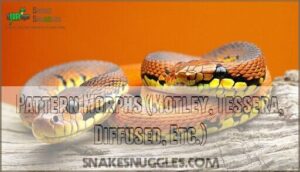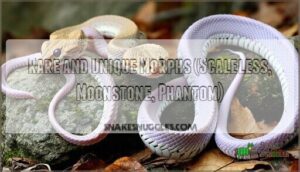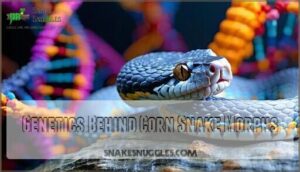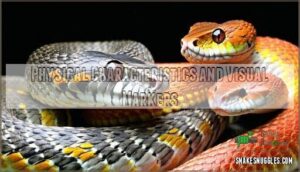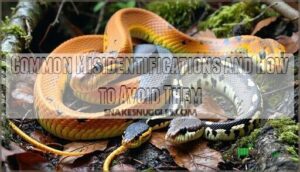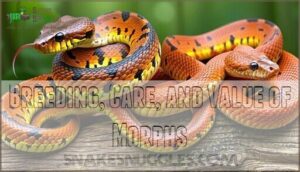This site is supported by our readers. We may earn a commission, at no cost to you, if you purchase through links.
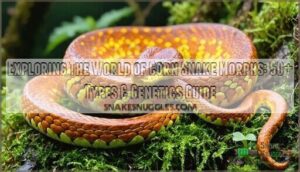
From vibrant amelanistic specimens that lack black pigment to intricate tessera patterns that reshape scale arrangements, each morph tells a story of selective breeding and genetic innovation.
What started as simple color variations has evolved into complex combinations that can command premium prices. Understanding the inheritance patterns behind these stunning creatures reveals how recessive and dominant genes work together to create nature’s most colorful surprises.
Table Of Contents
- Key Takeaways
- What Are Corn Snake Morphs?
- Types of Corn Snake Morphs
- Genetics Behind Corn Snake Morphs
- Identifying and Classifying Morphs
- Breeding, Care, and Value of Morphs
- Frequently Asked Questions (FAQs)
- Can corn snakes have more than one morph?
- How do you determine the gender of a corn snake?
- Are certain morphs more valuable than others?
- Can you breed different morphs of corn snakes together?
- How do you care for and maintain the health of corn snake morphs?
- Can corn snakes change morphs as they age?
- Do different morphs have different temperaments or behaviors?
- Which morphs are easiest for beginner breeders?
- How do environmental factors affect morph expression?
- Are certain morphs more prone to health issues?
- Conclusion
Key Takeaways
- Over 800 morphs from 33 genetic strains: Corn snake breeding has evolved from simple wild color variations into an intricate genetic system where 5 wild-type strains and 28 selected strains create hundreds of distinct combinations through predictable inheritance patterns.
- Three main categories define morph types: Color morphs like amelanistic remove specific pigments, pattern morphs like motley and tessera reshape scale arrangements, and rare morphs like scaleless represent unique genetic combinations that can command premium prices of up to $2,000.
- Genetics follow predictable rules: Most corn snake traits follow simple recessive or dominant inheritance patterns using Punnett squares, making breeding outcomes more reliable than expected when combining single-gene mutations or creating complex compound morphs.
- Market dynamics drive breeding decisions: Common morphs provide affordable entry points at $40-$75, while rare specimens command hundreds or thousands, creating a multi-million dollar industry where genetic knowledge becomes as valuable as proper husbandry skills.
What Are Corn Snake Morphs?
Corn snake morphs are genetic variations that create unique color and pattern combinations in these popular pet snakes.
With over 800 recognized morphs stemming from 33 genetic strains, these variations transform ordinary corn snakes into stunning specimens that captivate both breeders and pet owners alike.
Definition and History of Morphs
Think of corn snake morphs like nature’s paintbox went wild—what started as simple color variations in wild corn snakes has exploded into an astonishing genetic playground that’s completely transformed how we see these striking reptiles.
What started as simple wild color variations exploded into a genetic playground creating over 800 stunning corn snake morphs
Early breeders discovered these fascinating genetic traits through selective breeding, establishing naming conventions that reflect their historical significance in corn snake genetics:
- Morph Origins traced back to natural mutations found in wild populations
- Trait Discovery through dedicated hobbyists experimenting with inheritance patterns
- Snake genetics evolution from basic color variants to complex combinations
Overview of Recognized Genetic Strains
When exploring corn snake genetics, you’ll discover that breeders work with 33 recognized genetic strains—just 5 wild-type strains and 28 selected strains form the foundation of commercial production. These genetic strains create over 800 distinct corn snake morphs through various combinations and mutation types. Corn snakes are popular due to their diverse color morphs, making them a favorite among reptile enthusiasts.
| Strain Category | Number of Strains | Market Frequency |
|---|---|---|
| Wild-Type Strains | 5 foundational lines | Baseline genetics |
| Selected Strains | 28 specialized lines | 60%+ of morphs |
| Popular Morphs | Amelanistic, Motley | High availability |
All those morphs come from huge sections of chromosomes packed with thousands of genes that control how corn snakes look and what patterns they show.
Why Morphs Matter in The Pet Trade
Walk into any reptile expo, and you’ll quickly discover that corn snake morphs aren’t just pretty patterns—they’re the driving force behind a multi-million dollar industry that transforms simple genetics into living art. Consumer demand for unique genetic strains creates a fascinating economy where morph popularity directly influences price ranges and breeding decisions.
Here’s why corn snake morphs dominate the reptile trade:
- Collector Appeal – Rare morphs like scaleless specimens command premium prices
- Breeding Investment – Genetic diversity creates profitable long-term breeding projects
- Market Accessibility – Common morphs provide affordable entry points for new keepers
- Conservation Impact – Captive breeding reduces wild collection pressure
- Ethical Considerations – Responsible snake breeding promotes genetic health over novelty alone
The morph craze basically turned corn snakes into living collectibles overnight. Now breeders need to know genetics as much as they know feeding schedules and habitat setup.
Types of Corn Snake Morphs
Corn snake morphs fall into three main categories that showcase the remarkable genetic diversity within this species.
Color morphs, like amelanistic and lavender, alter pigmentation, while pattern morphs, such as motley and tessera, change scale arrangements.
Rare morphs, like scaleless and phantom, represent truly unique genetic combinations.
Color Morphs (Amelanistic, Lavender, Sunkissed, Etc.)
If you’ve ever wondered why some corn snakes look like living flames while others resemble delicate watercolors, you’re looking at the magic of color morphs in action. These Corn Snake Color Morphs showcase striking Visual Differences through genetic mutations.
Amelanistic genetics remove black pigment, creating vibrant reds and oranges. Lavender rarity produces stunning purple hues that collectors adore. Sunkissed variations add warm, golden undertones with Color Intensifiers that heighten natural beauty.
Pattern Morphs (Motley, Tessera, Diffused, Etc.)
While color morphs steal the spotlight, pattern morphs are where corn snakes really show off their artistic side—turning simple blotches into masterpieces that would make any abstract painter jealous.
Motley characteristics include clean bellies and faded dorsal patterns, while Tessera patterns create pixelated stripes with geometric precision. Diffused identification focuses on reduced belly checkerboards and softened blotches.
Pattern inheritance follows predictable genetic rules, making breeding patterns more reliable than you’d expect for creating these living canvases.
Rare and Unique Morphs (Scaleless, Moonstone, Phantom)
Beyond the common corn snake morphs lies a fascinating world of genetic rarities. The Scaleless corn morph, first bred by Richard Dijoux in France, lacks most scales due to reduced beta-keratin production. These unique snakes can cost up to $2,000.
Moonstone morphs combine Lavender and Anerythristic traits, creating pale tan patterns with purple-brown eyes. Phantom morphs blend Hypomelanistic and Charcoal genetics for ghostly gray coloration.
These rarest corn snake morphs present significant breeding challenges due to their complex genetic origins and limited market dynamics. They require the same care, including proper humidity levels, as their scaled counterparts.
Genetics Behind Corn Snake Morphs
Understanding corn snake genetics isn’t rocket science, but it’s the key that unlocks the rainbow of morphs you see today. These genetic blueprints work through simple inheritance patterns, single mutations, and careful breeding choices that create everything from ghostly pale amelanistics to boldly striped tesseras.
Basic Genetics and Inheritance Patterns
Think of corn snake genetics like a recipe book where each "ingredient" determines whether your snake ends up looking like a vibrant sunset or a ghostly phantom.
Most corn snake morphs follow predictable inheritance patterns using Punnett Squares to map outcomes. Recessive traits like amelanism need two copies to show, while dominant genes express with just one.
Once you know the genotypes and heritability factors, you can predict which genetic strains will pop up in the babies.
Single-Gene and Compound Mutations
Understanding mutation mechanisms in corn snake morphs reveals how genetic changes create stunning phenotype expression. Single recessive mutations like amelanism affect one gene, while compound mutations combine multiple genetic strains for complex breeding outcomes.
- CLCN2 gene mutations control both Motley and Stripe patterns through different mechanisms
- OCA2 gene disruption causes amelanistic traits, forming the base for 60% of compound morphs
- Market impact shows compound morphs now represent 55% of new hatchlings listed
- Research advances in genetic mapping have improved breeding predictability by identifying specific mutation intervals
A genetic calculator helps predict offspring when crossing single incomplete dominant traits with recessive morphs.
Selective Breeding and Polygenic Traits
Some of the most striking corn snake morphs you see today didn’t happen by accident—they’re the result of breeders who spent years fine-tuning traits that involve multiple genes working together. Polygenic inheritance creates gradual variations in snake color genetics, allowing breeders to establish specific breeding goals through trait fixation.
Getting these results takes real commitment. When you’re working with polygenic traits in corn snake morphs, you can’t just breed two snakes and expect magic. It’s a slow game that plays out over multiple generations of snake breeding, and there are some serious ethical questions to consider along the way.
Identifying and Classifying Morphs
Knowing how to identify corn snake morphs is like having a decoder ring for their genetic makeup.
You’ll need to spot key visual markers and avoid common mix-ups that trip up even experienced keepers.
Physical Characteristics and Visual Markers
When you’re staring at a corn snake for the first time, it’s like trying to decode a living piece of art—every scale, stripe, and shade tells a story about the genetic lottery that created this particular masterpiece. Look for key visual markers: scale patterns reveal whether you’re seeing smooth transitions or sharp boundaries between colors.
Eye color ranges from black to ruby-red in amelanistic morphs. Size variation and body shape remain consistent, but unique markings distinguish corn snake morphs—from bold blotches to pixelated geometry in tessera patterns.
Common Misidentifications and How to Avoid Them
Even seasoned reptile enthusiasts can mix up corn snake morphs—it’s like trying to tell identical twins apart when you’re only looking at baby photos.
Here’s how to avoid common snake morph identification pitfalls:
- Document color variations over time – Color fading changes appearance as snakes age
- Research breeder reputation – Reputable sources provide accurate genetic calculators for snakes
- Consider genetic testing – DNA analysis definitively identifies morph lookalikes and pattern variations
Getting your corn snake’s morph right takes patience and the right resources to back up what you’re seeing.
Breeding, Care, and Value of Morphs
Successfully breeding corn snake morphs requires careful selection of genetically compatible pairs and understanding market dynamics.
You’ll need to provide suitable housing conditions, monitor feeding schedules closely, and recognize that rare morphs can command premium prices from collectors.
Selecting and Pairing Breeders
Choosing the right breeding pairs is like matchmaking with a genetic twist—you’re not just looking for compatible personalities, but for complementary DNA that’ll create the next stunning morph.
Start by evaluating breeder health and lineage tracking records. Use genetic calculators and Punnett square calculators to predict morph combinations before pairing.
Ethical considerations matter—avoid inbreeding and prioritize genetic compatibility over profit when selecting cornsnake morphs for your breeding program.
Housing, Diet, and Shedding Needs
Your morph’s stunning genetics won’t mean much if basic husbandry falls short—proper housing, feeding schedules, and shedding assistance form the foundation that lets those beautiful traits truly shine.
Adult corn snakes need vivarium size matching their full length—usually 150cm x 50cm x 50cm. Maintain 40-60% humidity, increasing to 70% during shedding cycles. Choose appropriate substrate types like aspen shavings for burrowing.
Feed appropriately-sized prey every 7-14 days based on age. Monitor for shedding issues and provide humid hides when needed.
Market Value, Rarity, and Purchasing Tips
Corn snake morph price trends in 2024 showed significant drops across all tiers. Normal hatchlings averaged $40-75, while rare morphs like Scaleless commanded $500+.
Rarity and demand drive pricing—with over 800 morphs available, smart buyers research MorphMarket, attend reptile expos, and consider adoption options.
Ethical breeding practices guarantee healthy pet snakes with proper documentation.
Documentation, Health Guarantees, and Reputable Sources
Buying a corn snake without proper paperwork is like purchasing a car without a title—you might get what you want, but you’ll lack the proof and protection you need. Quality breeders understand that solid documentation separates professionals from backyard operations.
What you should expect:
- Genetic Testing results confirming morph verification and lineage
- Health Records from veterinary examinations and feeding histories
- Breeder Reputation verification through references and ethical breeding practices
- Hatchling birth certificates with parental genetic research data
- Morph Guide documentation explaining specific trait inheritance patterns
Proper documentation does two things: it protects your money and supports ethical breeding standards that benefit everyone in the hobby.
Frequently Asked Questions (FAQs)
Can corn snakes have more than one morph?
Absolutely. Combined trait expression creates stunning hybrid morphs when multiple morph inheritance occurs through breeding complex morphs together.
Visual identification challenges arise because morph interaction effects blend genetic traits from different mutation lines, producing corn snake morphs and colors that showcase multiple characteristics simultaneously.
How do you determine the gender of a corn snake?
Determining your corn snake’s gender isn’t always obvious from a glance. Experienced breeders use probing techniques and the popping method to identify sexual dimorphism.
DNA testing offers accuracy, though these methods require expertise for safe animal behavior assessment during reproduction seasons.
Are certain morphs more valuable than others?
Several factors drive morph desirability and pricing in corn snake markets. Rarity influence creates premium values—scaleless and moonstone mutations command thousands due to limited availability. Breeder reputation affects pricing considerably, with established producers charging more for proven genetic traits.
Investment potential varies; popular color morphs like lavender maintain steady demand, while newer mutations show volatile pricing.
Ethical considerations matter too—avoid supporting mills prioritizing profit over snake welfare.
Can you breed different morphs of corn snakes together?
When breeding different corn snake morphs together, you’re basically mixing genetic traits to create new morph combinations. Genetic compatibility between morphs determines what patterns and colors will appear in expected offspring.
- Simple recessive traits combine predictably when both parents carry the same mutation
- Compound morphs result from breeding snakes with multiple genetic traits together
- Breeding challenges arise with incompatible genes or reduced fertility in certain morph combinations
Understanding inheritance patterns helps predict morph rarity in offspring and guides successful corn snake breeding programs.
How do you care for and maintain the health of corn snake morphs?
Without a doubt, caring for corn snake morphs requires attention to morph-specific needs and genetic health considerations. Standard habitat maintenance includes proper temperature gradients, humidity levels between 40-70%, and appropriately sized enclosures.
Diet consistency matters—feed pre-killed rodents every 7-14 days based on your snake’s age and size. Monitor shedding challenges closely, as some morphs experience complications requiring increased humidity or veterinary care when problems arise.
Can corn snakes change morphs as they age?
What a "morph-ing" question! Once a corn snake hatches with specific genetic traits, its fundamental morph stays locked in – think of it as a genetic fingerprint. However, environmental factors and age can create subtle shifts in color intensification and pattern fading.
- Juvenile snakes often display more vibrant pigmentation that may soften with maturity
- Shedding cycles temporarily dull colors before revealing refreshed, sometimes slightly different hues
- Temperature and humidity variations can influence how genetic expression manifests visually
Your snake’s core mutation remains constant, but these natural changes keep morph identification interesting throughout their lives.
Do different morphs have different temperaments or behaviors?
There’s no scientific evidence that corn snake morphs have different personalities. The genetic changes that create different colors and patterns don’t affect how snakes behave—a snow morph acts just like a normal corn snake.
What really shapes a snake’s temperament? How you handle them and their environment. These factors matter way more than whether your snake has fancy patterns or unique coloration.
Which morphs are easiest for beginner breeders?
Nothing beats the simplicity of single recessive morphs for launching your breeding journey. These beginner-friendly genetics require straightforward pairings and produce predictable outcomes without breaking the bank.
- Amelanistic – Most readily available corn snake morph with simple inheritance patterns
- Hypomelanistic – Hardy morphs that pair easily with other low-cost morphs
- Anerythristic – Single recessive trait that’s forgiving for new breeders
- Caramel – Reliable genetics with consistent visual results across generations
- Lavender – Beautiful outcomes despite being one of the simpler morphs to work with
How do environmental factors affect morph expression?
You’d think after all these years studying corn snake genetics, the environment would play a bigger role in how morphs look. But honestly? It barely matters.
Sure, temperature affects how fast they grow, but it won’t change their colors or patterns. The morphs we see come from genetic mutations that are locked in from birth—no amount of environmental tweaking will alter them.
| Environmental Factor | Impact on Morphs |
|---|---|
| Temperature influence | Affects activity and appetite, not color |
| Humidity effects | Influences shedding quality, not patterns |
| Lighting impact | Maintains circadian rhythms, minimal color change |
| Diet variations | Affects overall health, not genetic expression |
| Habitat complexity | Reduces stress, doesn’t modify wildtype traits |
Corn snakes aren’t like some reptiles where temperature determines sex or changes appearance. If your snake has the amelanistic gene that blocks black pigment, different lighting won’t bring that black back.
That doesn’t mean environment is useless though. Good humidity during shed cycles keeps those crisp patterns looking sharp—exactly what morph collectors want to see. Poor feeding can make any snake’s colors look dull, but it won’t magically turn a tessera pattern into normal blotches.
Are certain morphs more prone to health issues?
While most morphs live perfectly normal lifespans, ethical breeders know they can’t just ignore the problem lines. You’ve got to actively avoid breeding snakes that carry these harmful mutations.
Most morphs show normal lifespan variations, but breeding ethics demands careful selection against harmful mutation lines.
Conclusion
Who would’ve thought that understanding genetics could lead to owning a living rainbow? Exploring the sphere of corn snake morphs reveals how simple breeding decisions create remarkable results.
From basic amelanistic traits to complex compound mutations, each morph represents years of careful selection. Whether you’re drawn to rare scaleless varieties or classic tessera patterns, these genetic masterpieces prove that science and beauty make perfect companions in the reptile world.
- https://cornsnake.net/pages/corn-snake-morph-photos
- https://www.unige.ch/medias/en/2025/un-seul-gene-definit-les-mille-motifs-de-la-peau-de-serpent
- https://reptilesmagazine.com/color-patterns-of-corn-snakes-determined-by-single-gene/
- https://pmc.ncbi.nlm.nih.gov/articles/PMC7584913/
- https://www.reddit.com/r/cornsnakes/comments/x1qff2/corn_snakes_breeding_phases_and_morphs/


